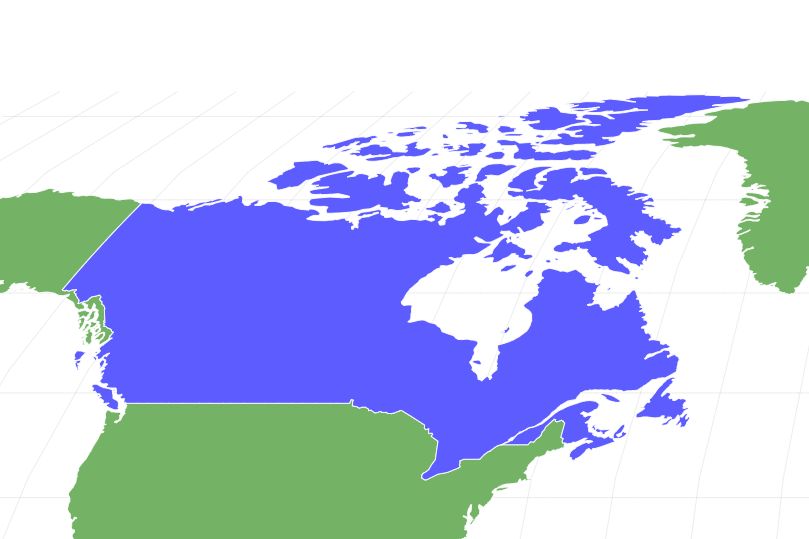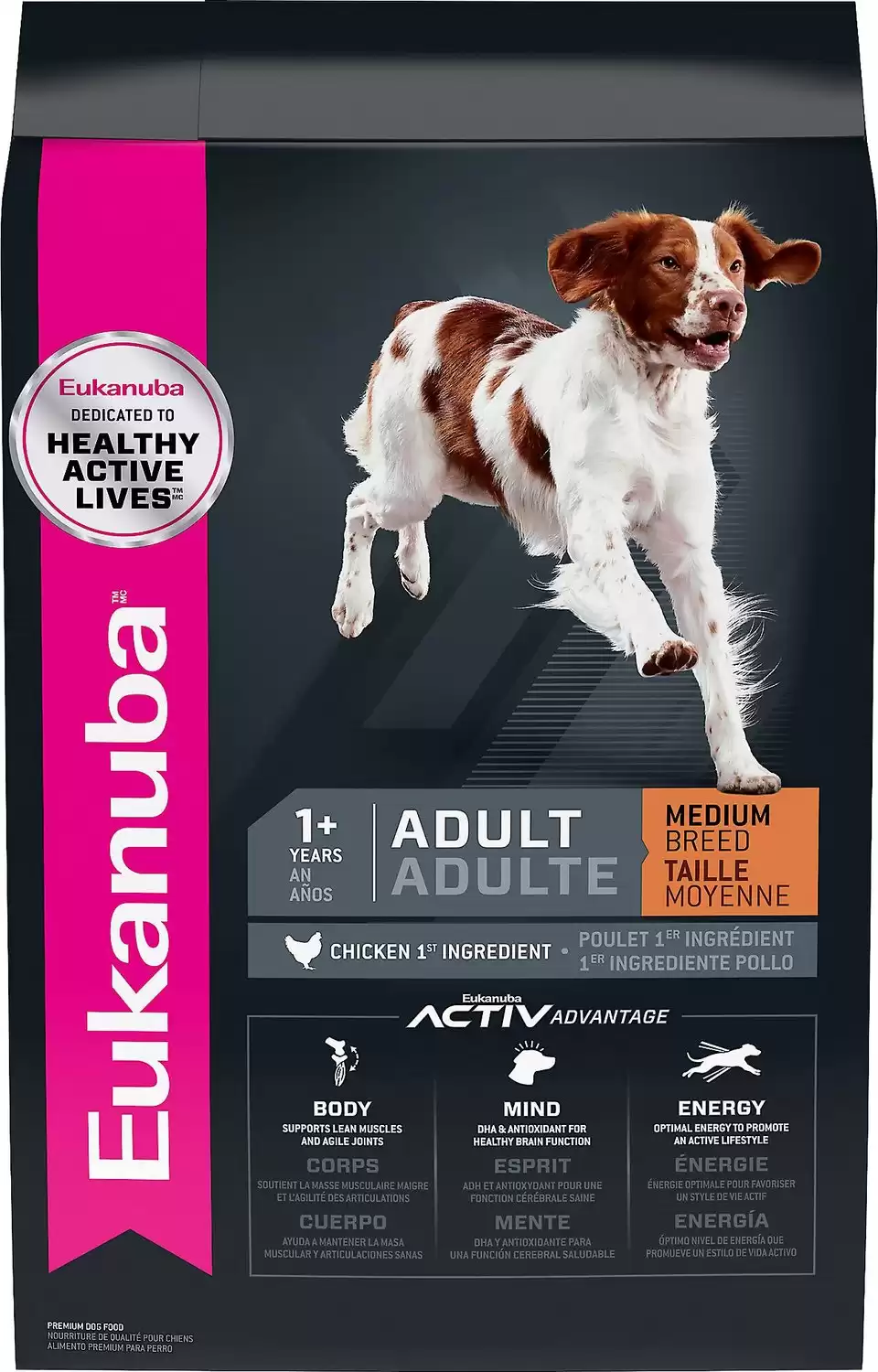Canadian Eskimo Dog
Canis lupus
Advertisement
Canadian Eskimo Dog Facts
Canadian Eskimo Dog as a Pet:
- General Health
- Energy Level
- Shedability
- Trainability
- Intelligence
- Tendency to Chew
- Size
- Family and kid friendliness
- Yappiness / Barking
- Moderate
- Separation Anxiety
- Low
- Preferred Temperature
- Cold climate
- Exercise Needs
- High
- Friendly With Other Dogs
- Moderate
- Pure bred cost to own
- $800 to $1200
- Dog group
- Working
- Male weight
- 66-88 lbs
- Female weight
- 39-66 lbs
This post may contain affiliate links to our partners like Chewy, Amazon, and others. Purchasing through these helps us further the A-Z Animals mission to educate about the world's species.
View all of the Canadian Eskimo Dog images!
The ancient Canadian Eskimo dog comes from the Canadian Arctic regions. These sled dogs are known for their exceptional energy and stamina and are hardworking rather than being speedy at work.
However, even though efforts have been made to protect these dogs and they have been around for a while, only a few are known to exist so far. The dogs are rarely seen as family pets. The breed is threatened by extinction in the present times.
See all of our expert product reviews.
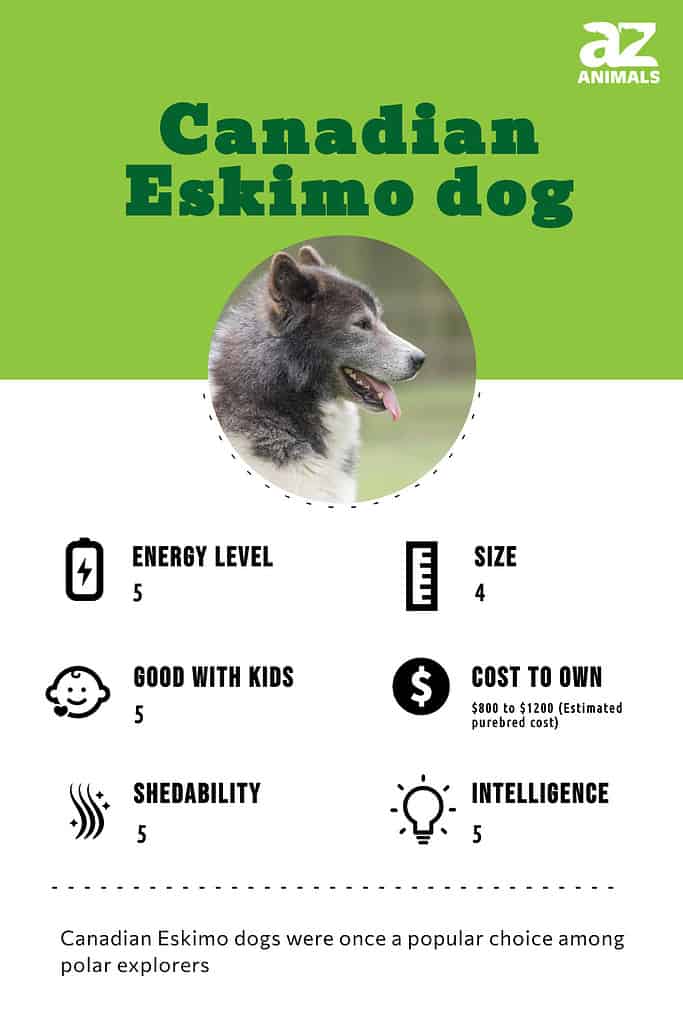
Three Pros and Cons of Owning Canadian Eskimo Dogs
| Pros! | Cons! |
|---|---|
| Can be great watchdogs If you are looking for a pet that also provides great security, this might be a great option to consider as and they are rather territorial watchdogs if their family is away. | Cannot stay in closed spaces for long These dogs have a high need to wander around and find it difficult to stay in closed spaces for long periods. |
| Great with children These dogs are known to be great with older children, as they do not like to be bothered with a busy and loud household. | Prone to a lot of health issues These dogs tend to be at a higher risk for health issues which can often lead to difficult scenarios for the owner. |
| Can handle being alone These dogs do not have aggressive behavior issues if and when left alone. They don’t often experience separation anxiety. | Stubborn These dogs can be very stubborn and can cause a great deal of difficulty for first-time owners. |
Size and Weight
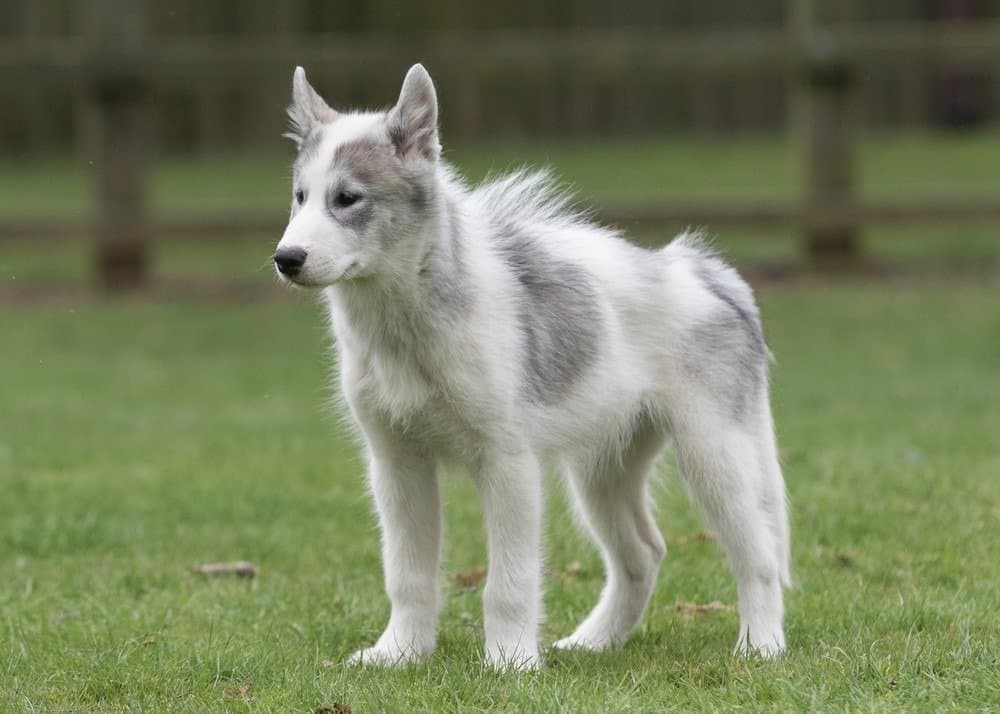
Canadian Eskimo Dogs are capable of reaching a maximum weight of 88 lbs
©Karen Appleby/Shutterstock.com
The male dogs are about 22 inches to 27 inches long while the female ones are about 19 inches to 23 inches.
Meanwhile, male dogs weigh around 66 pounds to 88 pounds. The female dogs weigh around 39 pounds to 66 pounds.
| Male | Female | |
|---|---|---|
| Height | 22 inches to 27 inches Tall | 19 inches to 23 inches Tall |
| Weight | 66 to 88 lbs., fully grown | 39 to 66 lbs., fully grown |
Origins
Once believed to be a descendant of the wolf, the Canadian Eskimo dog has since been proven to be lacking in any genes linking it to the former. However, the ancient origins of the breed are not in doubt – the Canadian Eskimo dog is believed to have existed for about 4,000 years. Out in the frozen Arctic, the hardy canine put its excellent tracking skills to good use hunting seals and polar bears, and pulling sleds across the ice, for several centuries.
Health and Entertainment for your Canadian Eskimo Dog
See all of our expert product reviews.
These hardy canines were also popular companions for explorers braving polar regions during the 1800s and the 1900s. However, in spite of having been present in the Arctic in large numbers during the early part of the 20th century, their population declined drastically by the middle of the century. However, thanks to the efforts of enthusiasts such as the Ekimo Dog Research Foundation, those figures which had plummeted drastically to just a few hundreds from tens of thousands recovered.
Common Health Issues
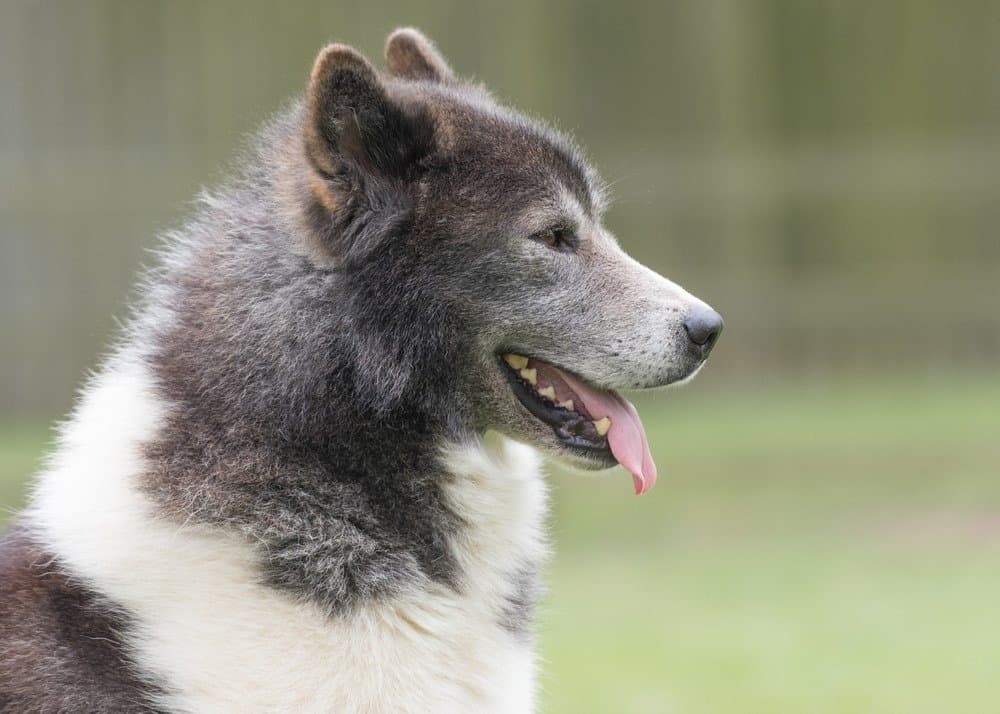
Canadian Eskimo Dog enjoy robust health but are however prone to conditions such as gastric torsion
©Karen Appleby/Shutterstock.com
These dogs are largely healthy. In fact, much of the reason for their low numbers has to do with the mass slaughter of Inuit dogs by the Royal Canadian Mounted Police from 1950 to 1970. Rumors say that this action was a tactic to intimidate the Inuit people at the time. Without many dogs left in the species, the preservation of their health is crucial.
Gastric torsion, which is a condition that is caused by the collection of gas in the stomach, can be life-threatening to the animal. Some signs that this twisting has occurred include the inability to vomit, rapid breathing, and frothing at the mouth.
Cataracts are also common, though these dogs may be likely to develop entropion (the inward turning of the eyelid) as well. Hip dysplasia and arthritis are both common issues as well, due to the reaction of the joints in warmer weather.
Therefore, Canadian Eskimo dogs suffer from the following diseases:
- Cataracts
- Hip Dysplasia
- Heat intolerance
- Entropion
- Gastric torsion
- Arthritis
Temperament

Canadian Eskimo Dogs are affectionate with family but must be monitored around smaller pets
©Nancy Bauer/Shutterstock.com
These dogs are known to be loving and affectionate and are gentle and loyal towards the family that they live with.
These dogs can often also develop great bonds with the owners to communicate with them. This breed, however, is not suitable for apartments and is often comfortable living outside. With its innate ability to perform as a watchdog, most people who adopt Canadian Eskimo dogs will be pleased with their lack of separation anxiety.
Though these dogs do not often seek out small animals as prey, households that have pets like cats and birds may want to supervise their dog and properly train them to prevent unfortunate accidents.
How to Take Care of Canadian Eskimo Dogs
With the endangered status of the Canadian Eskimo dog, taking care of it properly is crucial to the life of the species. Do not adopt a pup of this nature without fully understanding the commitment. Still, they are rather easy to care for with the right preparation.
The Best Dog Food for Canadian Eskimo Dogs

Canadian Eskimo Dogs require food which is high in protein
©Ansgar Walk / CC BY-SA 2.5 – License
These dogs require high-protein dog food. For particularly active and hardworking Canadian Eskimo dogs, supplementation with other meals and fat is helpful. Most adult dogs will eat twice a day, though the meals are a little lighter than if the dog was to feed once daily. Every dog is different, and owners will need to watch their dog’s feeding habits to determine when it is best to feed them.
These dogs also find it difficult to digest grains other than rice and corn. If you add foods like fruits, vegetables, eggs, or dairy products, it should be restricted to less than 10% of what they eat each day. Consuming typical “table food” is discouraged. As resistant as this dog is to unnecessary weight gain, this extra food can lead to issues in their digestive system and even obesity.
In our opinion at A-Z Animals, the best dog food for Canadian Eskimo dogs is Eukanuba Adult Medium Breed Dry Dog Food.
Between this breed’s risk of digestive troubles, cataracts, hip issues, and arthritis, a truly nutrient-rich diet is in order. Therefore, this quality chicken recipe is ideal. It has beta-carotene for eye health and glucosamine and chondroitin for mobile, pain-free joints. Finally, prebiotic fiber with a blend of probiotics aids digestion.
Here’s where to find Eukanuba Medium Breed Dog Food on Chewy or Amazon.
- Adult medium breed dry dog food formulated with complete and balanced nutrition for medium breed dogs over 12 months old and weighing between 24-54 lb.
- Promotes lean muscle development and joint health in active adult dogs with a combination of animal protein, glucosamine, and chondroitin sulfate.
- Helps keep dogs sharp and supports healthy brain function with DHA and vitamin E.
- Fuels an active lifestyle with optimal levels of fats and carbohydrates.
- High-quality chicken is the first ingredient for protein that powers his day.
Maintenance and Grooming
To groom your Canadian Eskimo dog, you should brush its fur or coat about two times a week. However, these dogs shed a lot during one particular period. During this part of the year, it becomes increasingly important to brush your dog’s coat daily. These dogs need to be groomed quite often, though the dense coat will require some work.
Despite the need to groom this dog’s coat, the winter months are quite easy. Most owners don’t even bathe their dogs through this time of year.
Dog Training
The Canadian Eskimo dogs are very easy to train, unlike other spitz breeds, and can quickly pick up commands during training. These dogs are known to be highly intelligent and usually need an authoritative and firm training teacher to learn best.
As intelligent as the Canadian Eskimo dog is, training it as a detection dog or a therapy dog isn’t especially helpful. Their training is much better suited for family life.
Exercise
Due to their breeding as a working dog, Canadian Eskimo Dogs need a high amount of daily exercise. Their quench for exercise will not be usually fulfilled with a simple walk and they would usually need to make a run. Even with plentiful exercise, avoid apartment living with this animal – their wanderlust could lead to behavior issues without the freedom to roam.
These dogs are usually also involved in dog sports like mushing, carting, or agility.
Puppies
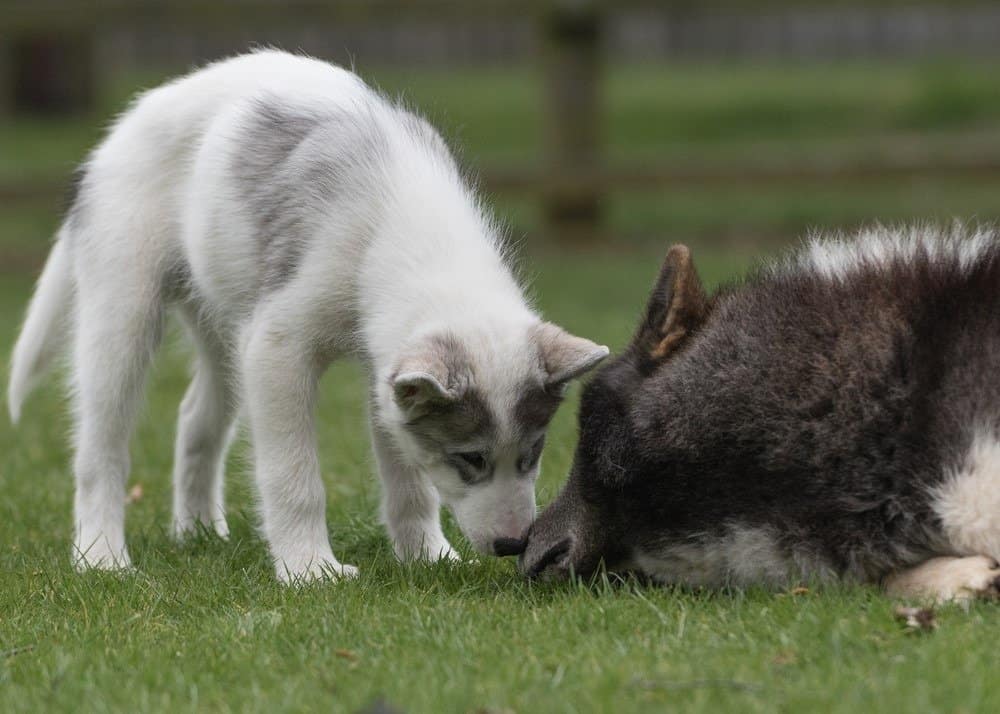
Canadian Eskimo puppies are pretty energetic and strong, however, they should be fed in small quantities
©Karen Appleby/Shutterstock.com
Even though the puppies can be given the same diet as the adult Canadian Eskimo dogs, they should be fed small quantities in a larger number of doses since it might prove difficult for puppies to digest huge quantities of food in one go.
Once puppies are weaned, they will need to eat a full bowl of food about four times a day. This number drops down to three bowls a day from 3 months old to six months old. From six months to one year, puppies will still need two meals a day. After one year, owners can feed the dog an adult diet.
Traditionally, the puppies of this breed are fitted with a harness as early as possible, allowing them to grow up with constant training. To encourage these pups to work hard, owners frequently pair puppies as young as 8 months old with adults to learn.
Children
These dogs are great with children. They are affectionate and loyal towards their owners and exhibit a special playful behavior around the children of the family. They are extremely loyal, but they may not like incredibly noisy households.
The territorial nature of these dogs may lead it to feel threatened around strangers. Even with family, it is common for these dogs to attempt to “herd” children in the same way that a dog on a farm may herd sheep. When children run and play, watch out for nipping at their ankles. While the behavior is not aggressive, an accidental injury may still happen.
Dogs Similar to Canadian Eskimo Dogs
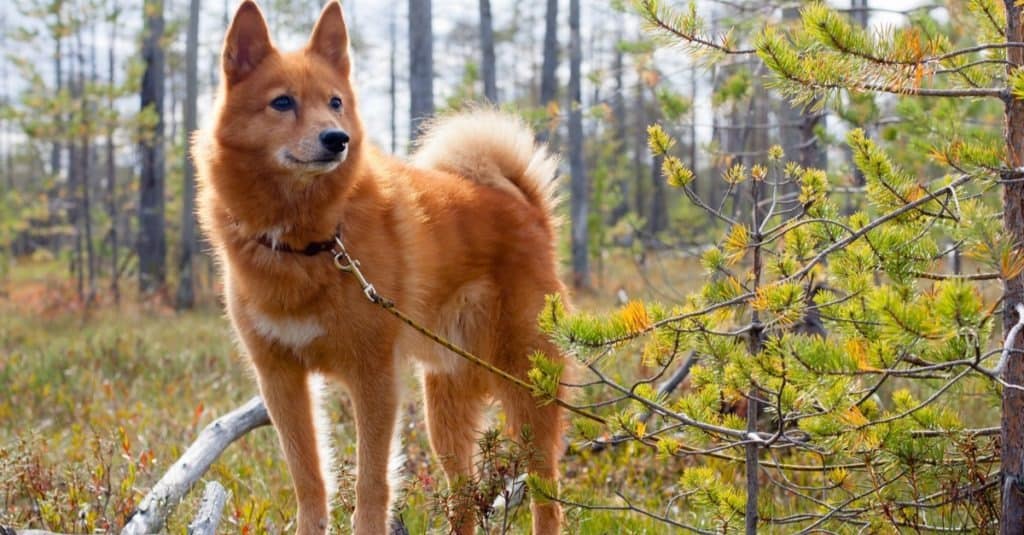
Finnish spitz are smaller than Canadian Eskimo Dogs but are more adaptable
©iStock.com/PavelRodimov
- Finnish Spitz: Though the Finnish Spitz is about half the size of the Canadian Eskimo dog, both have extremely dense coats to keep them warm in cold weather. Both dogs are loyal and affectionate, but the Finnish spitz is more accommodating to noise. The Canadian Eskimo Dog is much more sensitive to change.
- Greenland Dog: Researchers state that the Greenland dog has exactly the same genetic markers as the Canadian Eskimo dog. They are both playful and energetic, adapting well to Arctic conditions. However, the Greenland dog is better suited for changing lifestyles.
- American Eskimo Dogs: The American Eskimo dog shares the love of tranquility and remains non-combative like Canadian Eskimo Dogs. Both animals are also extremely intelligent, making training an easy task. However, the American dog is extremely vocal, barking much more than its Canadian relative.
Famous Canadian Eskimo Dogs
The Canadian Eskimo dog’s endangered status has kept it out of the spotlight apart from a few films. To promote awareness of their endangered status, the Canadian Eskimo dogs were the featured animal of The Last Dogs of Winter. The 2011 film is a documentary that featured 150 of these beautiful dogs.
Though the breed was previously synonymous with the Inuit people, their lack of numbers led it to be pulled from the American Kennel Club registry.
Popular Names for Canadian Eskimo Dogs
Here are some popular names for the Canadian Eskimo Dogs:
- Max
- Moose
- Mitsu
- Puddles
- Cloud
Canadian Eskimo Dog FAQs (Frequently Asked Questions)
How much does a Canadian Eskimo Dog cost to own?
These dogs usually cost around $800 to $1,200 for adoption. Grooming expenses could cost about $1,000 per year, depending on the groomer that you choose. The price of food will vary with the type of food that you select.
Is a Canadian Eskimo Dog good with kids?
Yes, these dogs are great with kids and are known to be extremely playful around them.
How long does a Canadian Eskimo Dog live?
These dogs usually live for about 10 to 15 years.
What climates are best for Canadian Eskimo dogs?
The Canadian Eskimo Dogs are the most comfortable in cold climates.
Do Canadian Eskimo dogs shed?
These dogs shed excessively during one phase of the year. Owners need to regularly have them groomed to prevent shedding.
How many Canadian Eskimo dogs are there?
There are approximately 300 Canadian Eskimo Dogs. These dogs, however, are faced with extinction right now.
How big do Eskimo dogs get?
The male dogs are about 22 inches to 27 inches long while the female ones are about 19 inches to 23 inches long.
Are Canadian Eskimo dogs good pets?
Even though these dogs are not usually kept as domestic and family pets, they still make great family companions and are affectionate and loyal towards their owners.
Are Canadian Eskimo Dogs extinct?
These dogs are currently threatened by extinction right now.
Are Canadian Eskimo Dogs herbivores, carnivores, or omnivores?
Canadian Eskimo Dogs are Omnivores, meaning they eat both plants and other animals.
What Kingdom do Canadian Eskimo Dogs belong to?
Canadian Eskimo Dogs belong to the Kingdom Animalia.
What phylum do Canadian Eskimo Dogs belong to?
Canadian Eskimo Dogs belong to the phylum Chordata.
What class do Canadian Eskimo Dogs belong to?
Canadian Eskimo Dogs belong to the class Mammalia.
What family do Canadian Eskimo Dogs belong to?
Canadian Eskimo Dogs belong to the family Canidae.
What order do Canadian Eskimo Dogs belong to?
Canadian Eskimo Dogs belong to the order Carnivora.
What type of covering do Canadian Eskimo Dogs have?
Canadian Eskimo Dogs are covered in Hair.
What is the scientific name for the Canadian Eskimo Dog?
The scientific name for the Canadian Eskimo Dog is Canis lupus.
Thank you for reading! Have some feedback for us? Contact the AZ Animals editorial team.
Sources
- The Kennel Club, Available here: https://www.thekennelclub.org.uk/search/breeds-a-to-z/breeds/working/canadian-eskimo-dog/
- Dogell, Available here: https://dogell.com/en/dog-breed/canadian-eskimo-dog
- Pet Guide, Available here: https://www.petguide.com/breeds/dog/canadian-eskimo-dog/
- Wikipedia, Available here: https://en.wikipedia.org/wiki/Canadian_Eskimo_Dog
- Animal Care Tips, Available here: https://animalcaretip.com/standard-canadian-eskimo-dog-care-tips/
- 101 Dog Breeds, Available here: https://www.101dogbreeds.com/canadian-eskimo-dog.asp
- The Canadian Encyclopedia, Available here: https://www.thecanadianencyclopedia.ca/en/article/canadian-inuit-dog

